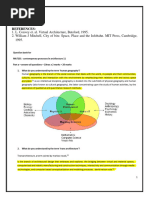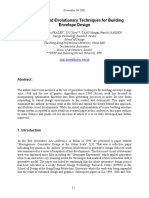0 ratings0% found this document useful (0 votes)
56 viewsInteractive Parametric Modelling: Responsive Louvres System: 4. Application and Case Studies
Pages from Thesis
Pages from Thesis
Pages from Thesis
Pages from Thesis
Pages from Thesis
Pages from Thesis
Pages from Thesis
Pages from Thesis
Uploaded by
Ayman_Elmasry_9107Copyright
© © All Rights Reserved
Available Formats
Download as PDF, TXT or read online on Scribd
0 ratings0% found this document useful (0 votes)
56 viewsInteractive Parametric Modelling: Responsive Louvres System: 4. Application and Case Studies
Pages from Thesis
Pages from Thesis
Pages from Thesis
Pages from Thesis
Pages from Thesis
Pages from Thesis
Pages from Thesis
Pages from Thesis
Uploaded by
Ayman_Elmasry_9107Copyright
© © All Rights Reserved
Available Formats
Download as PDF, TXT or read online on Scribd
You are on page 1/ 5
4.
Application and Case Studies
Figure 4.1: The Enclosure and Results [Zul04]
The main variable in the experiment was the ratio of enclosure wall solid
and void. Using an advanced draughting engine such Rhino and scripting
language such as Rhinoscript, the researcher was able to create a
responsive system with a generative random function to regulate the
amount of light penetrating the enclosure.
Interactive Parametric Modelling: Responsive Louvres
System
Another experiment by the same author [Zul04] was done using a
parametric design driven program called CATIA (Computer Aided
Three-Dimensional Interactive Application). The objective of this exercise
was also to modulate light at the enclosure level, but through shading.
The researcher used a number of vertical and horizontal louvres which
responded to two factors; the location of the sun throughout days of
different seasons which would affect the arrangement of the louvres, in
addition to the angle of incidence which affected the orientation of each
louvre as to reflect the light in a direction away from the building.
72
4. Application and Case Studies
Figure 4.2: Mapping Relationships [Zul04]
74
4.1. Thermal Responsive Design using Generative Systems and
Parametric Mapping
Figure 4.3: Automated Adaption [Zul04]
and witnessed real-time changes to building shape due to the change in
solar location (fig. 4.3)
The end result was quite similar to the initial design intentions (fig. 4.4).
75
4. Application and Case Studies
Figure 4.4: The Adaptable Pavilion [Zul04]
76
4. Application and Case Studies
2. Parametric delimited action: Semi-automated human intervention
3. Generative emergence rules
Parametric representation of the context. In order for the system
to be adaptive and responsive, the context should be variable, and
therefore parameterised. In the earlier work by the author (refer to section
4.1) the stimulus to which the building had responded was the sun and its
movement. Here however, the whole context of buildings, roads and the
rest of the stimuli mentioned earlier will affect the buildings response (see
fig. 4.7).
Figure 4.7: A plan view of the Kendall Square area being manipulated to
generate different context through parametric controls [Zul04]
Figure 4.8: An isometric of the Kendall Square [Zul04]
80
You might also like
- 0400-Gabriel Ivorra Morell - Dynamic SystemsNo ratings yet0400-Gabriel Ivorra Morell - Dynamic Systems167 pages
- From Moving Cube To Urban Interactive Structures: A Case StudyNo ratings yetFrom Moving Cube To Urban Interactive Structures: A Case Study8 pages
- Generative+Algorithms CaE Strip+MorphologiesNo ratings yetGenerative+Algorithms CaE Strip+Morphologies53 pages
- Emergence Form Finding in Nonlinear ArchitectureNo ratings yetEmergence Form Finding in Nonlinear Architecture6 pages
- Revised Development Control Norms in Tabulor Form 01.09.2014No ratings yetRevised Development Control Norms in Tabulor Form 01.09.201413 pages
- Contemperorary Process in Architecture - NotesNo ratings yetContemperorary Process in Architecture - Notes51 pages
- (INGLÉS) STUDIO AIR (Final Portfolio Submission)No ratings yet(INGLÉS) STUDIO AIR (Final Portfolio Submission)116 pages
- Interaction Narratives For Responsive ArchitectureNo ratings yetInteraction Narratives For Responsive Architecture11 pages
- Sustainable Materialization of Responsive ArchitectureNo ratings yetSustainable Materialization of Responsive Architecture20 pages
- Flexible Architecture: The Cultural Impact of Responsive Building100% (1)Flexible Architecture: The Cultural Impact of Responsive Building7 pages
- Kinetic Architecture Authors Name: Prof. Sharmila GangulyNo ratings yetKinetic Architecture Authors Name: Prof. Sharmila Ganguly24 pages
- Computational Design For Futuristic Environmentally Adaptive Building Forms and StructuresNo ratings yetComputational Design For Futuristic Environmentally Adaptive Building Forms and Structures12 pages
- Comparative Analysis of Technologies Used in Responsive Building FacadesNo ratings yetComparative Analysis of Technologies Used in Responsive Building Facades29 pages
- Generative and Evolutionary Techniques For Building Envelope DesignNo ratings yetGenerative and Evolutionary Techniques For Building Envelope Design16 pages
- Concepts: Environmentally Responsive Architecure Solar ControlNo ratings yetConcepts: Environmentally Responsive Architecure Solar Control2 pages
- Transformations:: An Arts Center For Narrows VirginiaNo ratings yetTransformations:: An Arts Center For Narrows Virginia65 pages
- Hygromorphic_materials_for_sustainable_rNo ratings yetHygromorphic_materials_for_sustainable_r38 pages
- P 2 - SAK - 4 Main Idea in Contemporary ArchitectureNo ratings yetP 2 - SAK - 4 Main Idea in Contemporary Architecture29 pages
- Movement Equations 2: Mathematical and Methodological SupplementsFrom EverandMovement Equations 2: Mathematical and Methodological SupplementsNo ratings yet
- Social Systems Engineering: The Design of ComplexityFrom EverandSocial Systems Engineering: The Design of ComplexityCésar García-DíazNo ratings yet
- Retrofitting Cities for Tomorrow's WorldFrom EverandRetrofitting Cities for Tomorrow's WorldMalcolm EamesNo ratings yet
- Joie Carseat Fortifi r Instruction ManualNo ratings yetJoie Carseat Fortifi r Instruction Manual65 pages
- Modelling Structures: 5.1 What Is A Good FEA Model?No ratings yetModelling Structures: 5.1 What Is A Good FEA Model?29 pages
- Haz Metal Anchor Bolts Technical CatalogueNo ratings yetHaz Metal Anchor Bolts Technical Catalogue22 pages
- 1.1 Computation and The Structural EngineerNo ratings yet1.1 Computation and The Structural Engineer7 pages
- Przewoznik Soszynski-How To Think in Chess PDFNo ratings yetPrzewoznik Soszynski-How To Think in Chess PDF287 pages
- JCI Achieving Competence in The Building Envelope SectorNo ratings yetJCI Achieving Competence in The Building Envelope Sector22 pages
- Haz Metal Natural Stone Fixings Catalog 03.2008ver1No ratings yetHaz Metal Natural Stone Fixings Catalog 03.2008ver143 pages
- Haz Metal Stone Attachments Technical Catalogue PDFNo ratings yetHaz Metal Stone Attachments Technical Catalogue PDF28 pages
- Voronoi Diagram Based Cumulative Approximation For Engineering OptimizationNo ratings yetVoronoi Diagram Based Cumulative Approximation For Engineering Optimization11 pages
- From Moving Cube To Urban Interactive Structures: A Case StudyFrom Moving Cube To Urban Interactive Structures: A Case Study
- Revised Development Control Norms in Tabulor Form 01.09.2014Revised Development Control Norms in Tabulor Form 01.09.2014
- Interaction Narratives For Responsive ArchitectureInteraction Narratives For Responsive Architecture
- Sustainable Materialization of Responsive ArchitectureSustainable Materialization of Responsive Architecture
- Flexible Architecture: The Cultural Impact of Responsive BuildingFlexible Architecture: The Cultural Impact of Responsive Building
- Kinetic Architecture Authors Name: Prof. Sharmila GangulyKinetic Architecture Authors Name: Prof. Sharmila Ganguly
- Computational Design For Futuristic Environmentally Adaptive Building Forms and StructuresComputational Design For Futuristic Environmentally Adaptive Building Forms and Structures
- Comparative Analysis of Technologies Used in Responsive Building FacadesComparative Analysis of Technologies Used in Responsive Building Facades
- Generative and Evolutionary Techniques For Building Envelope DesignGenerative and Evolutionary Techniques For Building Envelope Design
- Concepts: Environmentally Responsive Architecure Solar ControlConcepts: Environmentally Responsive Architecure Solar Control
- Transformations:: An Arts Center For Narrows VirginiaTransformations:: An Arts Center For Narrows Virginia
- P 2 - SAK - 4 Main Idea in Contemporary ArchitectureP 2 - SAK - 4 Main Idea in Contemporary Architecture
- Movement Equations 2: Mathematical and Methodological SupplementsFrom EverandMovement Equations 2: Mathematical and Methodological Supplements
- Handbook for Rooftop Solar Development in AsiaFrom EverandHandbook for Rooftop Solar Development in Asia
- Problems and Worked Solutions in Vector AnalysisFrom EverandProblems and Worked Solutions in Vector Analysis
- Social Systems Engineering: The Design of ComplexityFrom EverandSocial Systems Engineering: The Design of Complexity
- Modelling Structures: 5.1 What Is A Good FEA Model?Modelling Structures: 5.1 What Is A Good FEA Model?
- JCI Achieving Competence in The Building Envelope SectorJCI Achieving Competence in The Building Envelope Sector
- Haz Metal Natural Stone Fixings Catalog 03.2008ver1Haz Metal Natural Stone Fixings Catalog 03.2008ver1
- Haz Metal Stone Attachments Technical Catalogue PDFHaz Metal Stone Attachments Technical Catalogue PDF
- Voronoi Diagram Based Cumulative Approximation For Engineering OptimizationVoronoi Diagram Based Cumulative Approximation For Engineering Optimization





















































































